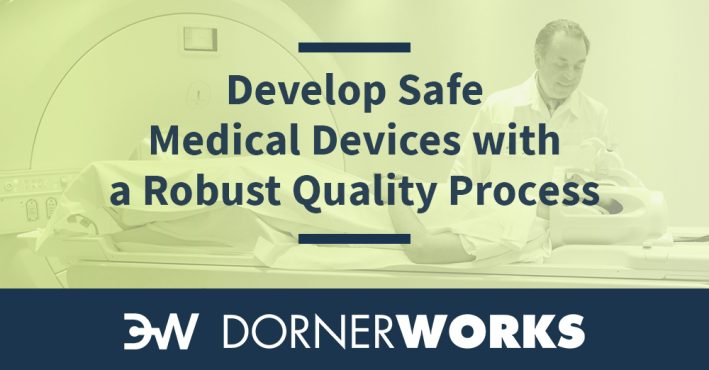
One of the ways engineers develop medical devices that meet safety requirements is by following a standardized medical device development process.
The medical device development process requires specific stages to be followed to ensure design control so that the product is both effective and safe for use. As a result, this covers the entire product development cycle, from medical device design to clinical trials, and risk management to manufacture.
That process differs with the context and environment of the device, but there are some steps in the medical device product development lifecycle that apply globally. These steps include initial concept, product design, prototyping, device testing, design verification and validation, and medical device manufacturing.
The exact implementation of the medical device development process differs between the United States, EU, UK and other regions, but safety is a key component of all of them. DornerWorks engineers use a V-model of medical device development to ensure the same, though it is not the only model available.
The V-model of the medical device systems development lifecycle is a diagram of the development process, but it’s not the development process itself. The V-model tells developers that they need to write requirements, build out architecture, develop a system design, and implement the project in code, but it doesn’t explicitly state how those tasks must be done.

As DornerWorks technology strategy leader and medical device security expert Dan Rittersdorf says, it essentially shows what is needed to develop safer, better medical devices.
At each level of the V-model, different types of verification need to be planned for and carried out. That can involve unit testing, integration testing, or testing the results of each stage to verify the outcome.
“At that point, when the project is finished and a developer asks the question, ‘Did we build the thing right?’ The answer should be ‘Yes, we did. We fully completely implemented and verified the medical device. Therefore we’ve developed the product right,'” Rittersdorf says.
The V-model that DornerWorks engineers follow is one description of the tasks involved in developing a medical device. Other companies may use modified versions, depending on their industry, so long as one is used.
“The law requires that medical device manufacturers must follow a quality management process,” Rittersdorf says. “They need to follow good management practices, and they need to be able to provide evidence that they did that.”
The FDA has provided guidance for Medical Device Manufactures to help them prepare Medical Devices for marketability. This quality system regulation (QSR) governs “the methods used in, and the facilities and controls used for, the design, manufacture, packaging, labelling, storage, installation, and servicing of all finished devices intended for human use.”
DornerWorks understands the QSR in terms of the following five stages:
Ignore the quality process and you risk leaving out more than just quality.
“The greatest risk in not following the process is developing an unsafe and ineffective device that could harm a patient or the operator,” Rittersdorf says.
The medical device development process is a risk-based approach that looks at signs of potential harm and recommends mitigations that then lower the level of harm. Where that process has not been applied, a device manufacturer risks a Corrective And Preventative Action from the FDA, potentially prompting a device recall or a field update.

In any development process, the earlier a problem is found the less costly it is to repair, in more ways than one. No developer wants their name to be linked to medical devices that are being recalled.
“There are several manufacturers going through very expensive recalls right now,” Rittersdorf says. “We don’t want our customers to experience that. So, we advise them up front to follow the process in great detail so that they can avoid those problems later.”
Developing and gaining approval for a new medical device can take months or even years depending on the type of device being developed.
Scientific studies show that it takes three to seven years to bring a device from concept to approval. That includes the entire device lifecycle, including research, development and testing.
The FDA provides guidelines for approval duration based on the different classes of medical devices:
Class 1 Devices can be self-registered with the FDA and can be completed in as little as one week. These devices are non-invasive, pose low health risk to the operator, and include items such as tongue depressors, oxygen masks and electric toothbrushes.
Class 2 devices have a moderate risk associated with them and comprise 43% of all medical devices. The average time to receive clearance is almost 6 months, with just 19% being cleared within three months. Examples include items such as contact lenses, catheters and syringes. Manufacturers of Class 2 Devices must be able to prove device safety and efficacy through substantial comparison to another approved device.
Class 3 Devices pose the highest risk to patients, and include items such as cochlear implants, defibrillators, and implanted prostheses. Class 3 Devices make up just 10% of all medical devices on the market. They require the most stringent checks during the development process, with an average approval process of over eight months.
As a supplier of medical device software and hardware, DornerWorks engineers follow practices conformant with ISO 9001, the foundation of all our quality processes, that includes:

DornerWorks engineers follow this quality management system “by the book,” and may work within a customer’s quality system to help meet their product goals. Throughout the development lifecycle, evidence is carefully documented to verify that the products have been developed correctly and safely.
Quality medical device development is important to you and your customers, and that’s why it’s important to us. Schedule a meeting with our team to discuss your next product. We will help you map out a plan that turns your ideas into reality.